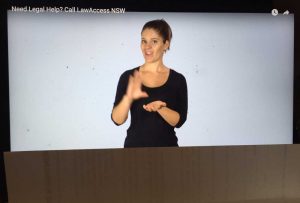About These Resources
The resources were created to support a workshop in Auckland on 2 February 2017. To see more about that workshop, click here.
Note: the page may be slow in loading because of the amount of video included.
Strategies for Working with Texts with Translation Support
Here are some strategies for using texts that have a translation in the target language to accompany the original source text. I am using the example of a text in New Zealand Sign Language with a written (captioned) English translation, but these strategies could potentially be used for any language pair.
Working from NZSL to English:
- Interpret the video blocking captions (and with sound off if the video as a spoken English translation). It is most helpful if you can record your interpretation to review and reflect on – as well as to compare to the original translation in the next step.To block the captions, simply fold up a sheet of paper and lean it against your computer monitor. Here’s an example:
Original Video

After Covering Captions

- Read the captioned English version (or listen to spoken English translation). Compare this source to your interpretation in step 1. Note the areas that you were on target as well as the places where your interpretation diverged. What was happening in the video at those points? Does that fit with any patterns that you see in your work?
- Re-Interpret the video with the captions blocked (and sound off ). Try to incorporate what you learned from Step 2 in your new interpretation. (This is not cheating. This is an opportunity to practice fluency in our work.)
Working from English to NZSL:
- Interpret from English to NZSL: If there is no English translation, record yourself reading the captions or have someone else do it for you so you are not tempted to watch the sign language. Listen to the English recording or translation of the video. Interpret this into NZSL. Again, it is best to record yourself to assist in analysis and reflection.
- Watch the original NZSL version. Compare this source to your interpretation in step 1. Note the areas that you were on target as well as the places where your interpretation diverged. What was happening in the video at those points? Does that fit with any patterns that you see in your work?
- Re-Interpret again using the English translation as source. Try to incorporate what you learned from Step 2 in your new interpretation. (This is not cheating. This is an opportunity to practice fluency in our work.)
The text below is from a review of the New Zealand Sign Language Act. It is designed to give an idea of who this might work.
The New Zealand Sign Language Original Text
The Video (Captions blocked)
The Video without Captions (in Parts)
This page provides links to work with this video in segments. The video will start and stop at predetermined points. This allows you to practice in a more consecutive format without worrying about stopping the video yourself. (To see how to do this yourself with YouTube videos, check out this post on “Quoting from Visual Languages.”)
Part 1
Part 2
Part 3
Part 4
Part 5
Part 6
Part 7
Part 8
Part 9
Part 10
Part 11
Part 12
Part 13
Part 14
The Video with Audio
NZSL Act Review Video with Captions & Audio
The following video includes a spoken English audio track. This allows you to practice interpreting into NZSL – and then compare back to the original source text.
(Please forgive the American accent as well as my lack of familiarity with some of the terminology, but just trying to demonstrate that resources don’t have to be perfect to help with your progress in professional development.)
